Guimet Museum
The Guimet Museum (French: Musée national des arts asiatiques [MNAAG] or Musée Guimet) is an art museum located at 6, place d'Iéna in the 16th arrondissement of Paris, France. It has one of the largest collections abroad of Asian art.
History
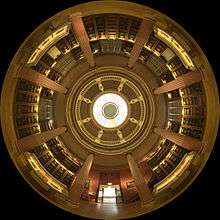
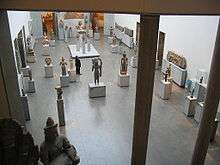
Founded by Émile Étienne Guimet, an industrialist, the museum first opened at Lyon in 1879[1] but was later transferred to Paris, opening in the place d'Iéna in 1889.[2] Devoted to travel, Guimet was in 1876 commissioned by the minister of public instruction to study the religions of the Far East, and the museum contains many of the fruits of this expedition, including a fine collection of Chinese and Japanese porcelain and many objects relating not merely to the religions of the East but also to those of ancient Egypt, Greece and Rome. One of its wings, the Panthéon Bouddhique, displays religious artworks.
Some of the museum's artifacts were collected from Southeast Asia by French authorities during the colonial period.[3]
From December 2006 to April 2007, the museum harboured collections of the Kabul Museum, with archaeological pieces from the Greco-Bactrian city of Ai-Khanoum, and the Indo-Scythian treasure of Tillia Tepe.
Works of art of the museum
Greco-Buddhist art
- Gandhara Buddha, 1st–2nd century CE
- Hellenistic decorative scrolls from Hadda, northern Afghanistan
 Standing Buddha, ancient region of Gandhara, northern Afghanistan, 1st century
Standing Buddha, ancient region of Gandhara, northern Afghanistan, 1st century- Wine-drinking and music, Hadda, 1st–2nd century CE
- A Corinthian capitol with a Buddha at its center, 2nd century, Surk Kotal, Afghanistan
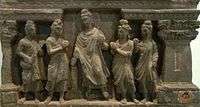 Scene of the life of the Buddha. 2nd–3rd century. Gandhara
Scene of the life of the Buddha. 2nd–3rd century. Gandhara- Portraits from the site of Hadda, 3rd century
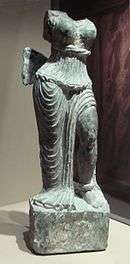
Serindian art
 "Heroic gesture of the Bodhisattva", 6th–7th century terracotta, Tumshuq (Xinjiang)
"Heroic gesture of the Bodhisattva", 6th–7th century terracotta, Tumshuq (Xinjiang)- Head of a Bodhisattva, 6th–7th century terracotta, Tumshuq (Xinjiang)
Chinese art
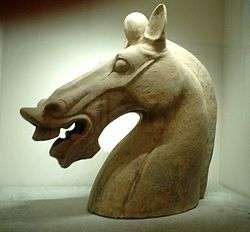 Han Dynasty Horse (1st–2nd century)
Han Dynasty Horse (1st–2nd century)- Buddha triad, Eastern Wei (534–550), China
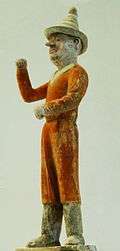 Tang dynasty Foreign Merchant
Tang dynasty Foreign Merchant Northern Qi depiction of Sogdians
Northern Qi depiction of Sogdians.jpg) One of the Group of glazed pottery luohans from Yixian, c. 1000
One of the Group of glazed pottery luohans from Yixian, c. 1000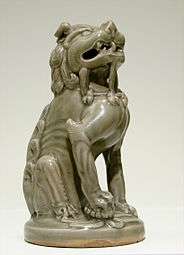 A sitting celadon lion, dated 11th to 12th century, Song dynasty
A sitting celadon lion, dated 11th to 12th century, Song dynasty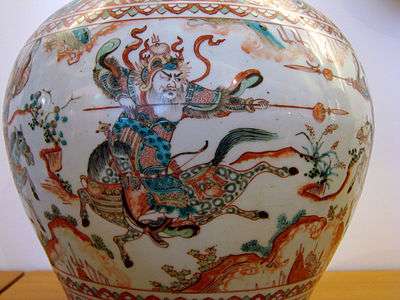 A porcelain vase with design of men fighting on horseback, from the Jiajing reign period (1521–1567), Ming dynasty
A porcelain vase with design of men fighting on horseback, from the Jiajing reign period (1521–1567), Ming dynasty A round sancai dish from the Tang dynasty, 8th to 9th century
A round sancai dish from the Tang dynasty, 8th to 9th century Painting Bodhisattva Who Leads the Way from Mo-kao caves, 900–950 A.D.
Painting Bodhisattva Who Leads the Way from Mo-kao caves, 900–950 A.D.
Indian art

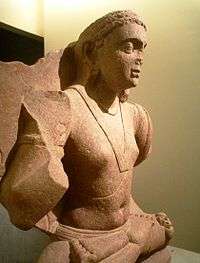 The Bodhisattva Maitreya, 2nd century, Mathura
The Bodhisattva Maitreya, 2nd century, Mathura- A Buddha, 2nd century, Mathura
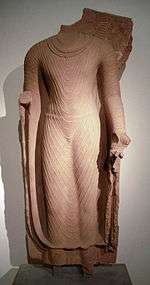 Buddha of the Gupta period, 5th century, Mathura
Buddha of the Gupta period, 5th century, Mathura- Head of a Buddha, Gupta period, 6th century
- Rishabhanatha, sandstone, Madhya Pradesh, Chandela period, 10th–11th century
- Buddha and Bodhisattvas, 11th century, Pala Empire
.jpg) Vishnu, Madhya Pradesh, 11th–12th century
Vishnu, Madhya Pradesh, 11th–12th century.jpg)
- Rishabhanatha, 11th–12th century, Orissa
Southeast Asian art

- Agastya, c. 8th–9th century Central Java, Indonesia
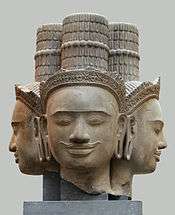
- Brahma 10th century, Cambodia
- Shiva from Vijayapura, Vietnam
)_(7233496060).jpg) Ganesha, Siem Reap, Cambodia, c. 12th–13th century
Ganesha, Siem Reap, Cambodia, c. 12th–13th century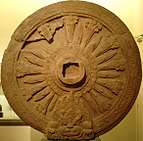 Mons Wheel of the Law (Dharmacakra), art of Dvaravati, c. 8th century
Mons Wheel of the Law (Dharmacakra), art of Dvaravati, c. 8th century- A Cambodian Buddha, 14th century

See also
Notes
- History of the Museum (in French).
- National museum Arts asiatiques – Guimet, Marie-Catherine Rey et al. Paris: Éditions de la Réunion des Musées nationaux, 2001, translation by John Adamson, ISBN 2711838978, Chronology, p. 6.
- Patrick Howlett-Martin, « Où ira le buste de Néfertiti ? », Le Monde diplomatique, no 700, juillet 2012, p. 27.